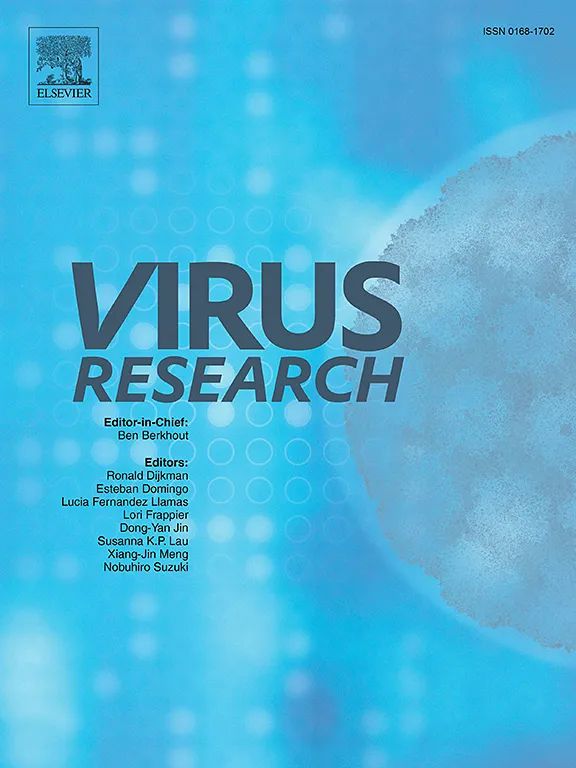Characterization and antibody preparation of the gene products of grouper iridovirus ORF120L
IF 2.7
4区 医学
Q3 VIROLOGY
引用次数: 0
Abstract
Grouper iridovirus (GIV) is regarded as a prominent viral pathogen of grouper, particularly during the larval and juvenile stages. The aim of this study was to comprehensively characterize the GIV-120L gene during viral infection. The results of sequence analysis suggest that GIV-120L is a 1,470 bp gene encoding a Ranavirus-specific viral protein. Recombinant GIV-120L protein was purified using a nickel-affinity column, and its molecular weight was found to be 59.1 kDa. To obtain antibodies against GIV, mice were immunized with recombinant GIV-120L protein, the spleen was harvested 8 weeks later, and hybridoma testing was performed using Sp2/0 myeloma cells. Polyclonal and monoclonal antibodies against GIV-120L were obtained. To characterize GIV-120L gene expression, grouper kidney (GK) cells were infected with GIV using cycloheximide (CHX) and cytosine arabinoside (AraC). GIV-120L transcripts and protein were found at 12–30 h post infection (hpi) and 18–30 hpi, respectively. In addition, inhibition with CHX and AraC confirmed that GIV-120L was a late gene. Immunofluorescence staining using the antibodies produced in the study confirmed that GIV-120L protein is expressed at viral assembly sites at 24 hpi. The findings of this study provide functional characterization of the GIV-120L viral gene, enhance understanding of GIV assembly, and offer insights for GIV diagnostic applications.
石斑鱼虹膜病毒ORF120L基因产物的鉴定及抗体制备
石斑鱼虹膜病毒(Grouper iridovirus, GIV)被认为是石斑鱼的主要病毒病原体,特别是在幼虫和幼鱼阶段。本研究的目的是在病毒感染期间全面表征GIV-120L基因。序列分析结果表明,GIV-120L是一个1,470 bp的基因,编码ranvirus特异性病毒蛋白。重组GIV-120L蛋白经镍亲和柱纯化,分子量为59.1 kDa。为了获得抗GIV抗体,用重组GIV- 120l蛋白免疫小鼠,8周后收获脾脏,用Sp2/0骨髓瘤细胞进行杂交瘤检测。获得抗GIV-120L的多克隆和单克隆抗体。用环己亚胺(CHX)和阿拉伯糖胞嘧啶(AraC)感染石斑鱼肾(GK)细胞,检测GIV- 120l基因的表达。在感染后12-30 h (hpi)和18-30 hpi分别发现了GIV-120L转录本和蛋白。此外,CHX和AraC的抑制作用证实了GIV-120L是一个晚期基因。利用本研究产生的抗体进行免疫荧光染色,证实GIV-120L蛋白在24 hpi的病毒组装位点表达。本研究结果提供了GIV- 120l病毒基因的功能表征,增强了对GIV组装的理解,并为GIV诊断应用提供了见解。
本文章由计算机程序翻译,如有差异,请以英文原文为准。
求助全文
约1分钟内获得全文
求助全文
来源期刊

Virus research
医学-病毒学
CiteScore
9.50
自引率
2.00%
发文量
239
审稿时长
43 days
期刊介绍:
Virus Research provides a means of fast publication for original papers on fundamental research in virology. Contributions on new developments concerning virus structure, replication, pathogenesis and evolution are encouraged. These include reports describing virus morphology, the function and antigenic analysis of virus structural components, virus genome structure and expression, analysis on virus replication processes, virus evolution in connection with antiviral interventions, effects of viruses on their host cells, particularly on the immune system, and the pathogenesis of virus infections, including oncogene activation and transduction.
 求助内容:
求助内容: 应助结果提醒方式:
应助结果提醒方式:


